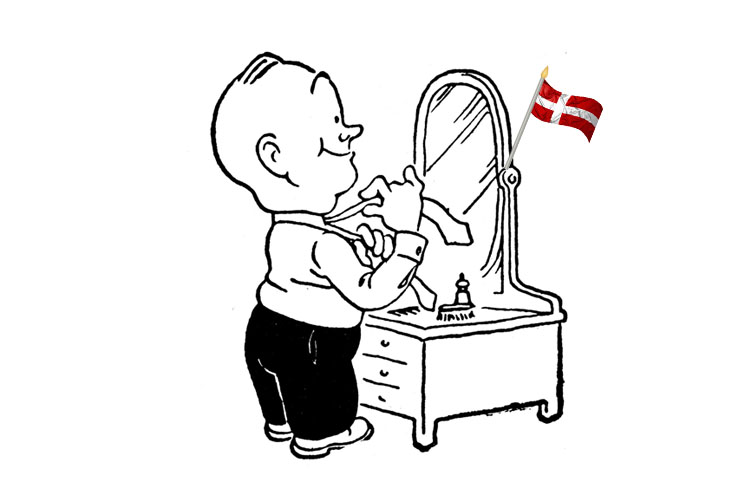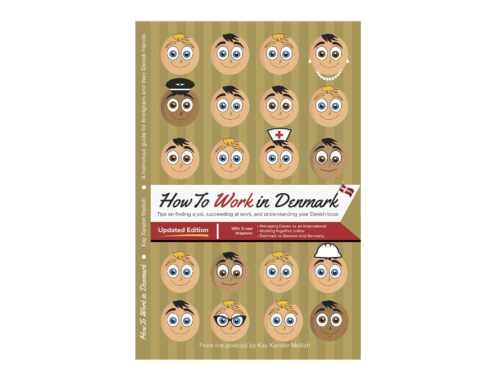I’ve been away from the podcast for a couple weeks. I’ve been on vacation in the USA. But I’m back now, and it only takes a few minutes after I arrive at Kastrup airport before something happens to destroy the relaxing effect of 2 weeks off and several thousand kroner spent on spas, hotels and tasty dinners.
The jolt back to reality usually happens at baggage claim, when one of my fellow fliers of the Danish persuasion bumps right into me at the baggage carousel without saying Excuse me, or Pardon, or Entshculdigung, or any of those other nice oops-I’ve-just-run-into-you phrases so common in the rest of the world. For Danes, the standard response after accidentally running into someone is a sullen grunt – HUMPH – along with a sour look of annoyance that you got in their way.
And if I don’t get bumped into at the airport, there’s bound to be a letter from the tax department waiting when I get home. If it’s not the Danish tax department, it’s the American tax department, as it was this time. I came home from my relaxing vacation to a completely nonsensical letter from the IRS, written by a machine, sent for some reason in duplicate, asking for six hundred dollars.
A foot in two different countries
But that’s what it’s like when you have a foot in two different countries. Not just two sets of taxes and tax bureaucrats, but two driver’s licenses and two sets of eyeglass prescriptions, since one country won’t accept the other’s. In each country, I have two sets of pensions, public and private. That means four pension plans, and I basically don’t understand any of them.
What’s most alarming is when you can see your home country slipping out of focus and Denmark starting to feel like home.
When you go back to your country of origin, it can be alarming to realize how Danish you are becoming.
I remember when I first came to Denmark, I thought, “Their cars are so small. How cute!” Now, when I’m in the U.S., I think, ”Why do they need such big cars?”
Becoming a dual citizen
Denmark began allowing dual citizenships in 2015, and I was one of the first to apply. This required a language test – including a spoken-word test that required me to create a story around a cartoon image of a lady running to catch a bus. I made up a long and involved story about her troubled love affair with the bus driver. That seemed to satisfy (and interest) the team of examiners.
I also had to take a written test about the various aspects of the Danish government and economy, for which I studied a hefty document about shipping and agriculture. Almost none of that was on the test, which was an easy set of questions like, “Is it free to borrow books from the library in Denmark?”
(Shortly after, a less immigrant-friendly government was elected, and my test was replaced with extraordinarily difficult questions like, “When was composer Carl Nielsen born?” Many native-born Danes complained that they were unable to answer these questions themselves.)
Finally, having passed both the language and national knowledge tests, I was sent to the Danish police for a comprehensive interview. A tough-looking lady who apparently no longer had the stomach for outdoor police work spent an hour questioning me on every aspect of my life, including the kindergarten I attended when I was four. When she was done, she presented me with a typed-out version of everything I had said. I had to sign at the bottom.
That document is now public record; anybody who really wants to can examine it up until my citizenship application goes before the Danish parliament this spring. Every new citizen has to be approved by the Danish parliament, although they usually do this in batches of 100 or so.
Now I am a salty
I look forward to dual citizenship. Instead of trying to remember where I put my passport, now I can try to remember where I put two passports.
And it seems I’ve become a salty.
Salty – or soutpiel – is an old South African expression. It was a way the white Afrikaans speakers, who were dedicated to South Africa, referred to the white English speakers, who they said had one foot in South Africa and one foot in the UK. This meant that their personal bits were dipped in salt water.
I’ve got one foot in Denmark and one foot in the U.S., which I suppose makes me a salty, too.
Buy Kay’s books about Denmark on Amazon, Saxo, Google Books, Apple Books, Barnes & Noble Nook, or via our webshop.
Image mashup copyright Kay Xander Mellish 2025
Read also:
Danish Vikings, or how to find Vikings in today’s Denmark





